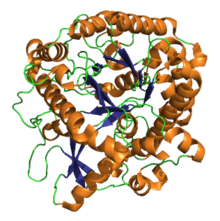Myrosinase
| Thioglucosidase (Myrosinase) | |||||||||
|---|---|---|---|---|---|---|---|---|---|

Myrosinase from Sinapis alba. PDB 1e4m
|
|||||||||
| Identifiers | |||||||||
| EC number | 3.2.1.147 | ||||||||
| CAS number | 9025-38-1 | ||||||||
| Databases | |||||||||
| IntEnz | IntEnz view | ||||||||
| BRENDA | BRENDA entry | ||||||||
| ExPASy | NiceZyme view | ||||||||
| KEGG | KEGG entry | ||||||||
| MetaCyc | metabolic pathway | ||||||||
| PRIAM | profile | ||||||||
| PDB structures | RCSB PDB PDBe PDBsum | ||||||||
| Gene Ontology | AmiGO / EGO | ||||||||
|
|||||||||
| Search | |
|---|---|
| PMC | articles |
| PubMed | articles |
| NCBI | proteins |
Myrosinase (EC 3.2.1.147, thioglucoside glucohydrolase, sinigrinase, and sinigrase) is a family of enzymes involved in plant defense against herbivores. The three-dimensional structure has been elucidated and is available in the PDB (see links in the infobox).
A member of the glycoside hydrolase family, myrosinase possesses several similarities with the more ubiquitous O-glycosidases. However, myrosinase is the only known enzyme found in nature that can cleave a thio-linked glucose. Its known biological function is to catalyze the hydrolysis of a class of compounds called glucosinolates.
Myrosinase is regarded as a defense-related enzyme and is capable of hydrolyzing glucosinolates into various compounds, some of which are toxic.
Myrosinase catalyzes the chemical reaction
Thus, the two substrates of this enzyme are thioglucoside and H2O, whereas its two products are sugar and thiol.
In the presence of water, myrosinase cleaves off the glucose group from a glucosinolate. The remaining molecule then quickly converts to a thiocyanate, an isothiocyanate, or a nitrile; these are the active substances that serve as defense for the plant. The hydrolysis of glucosinolates by myrosinase can yield a variety of products, depending on various physiological conditions such as pH and the presence of certain cofactors. All known reactions have been observed to share the same initial steps. (See Figure 2.) First, the β-thioglucoside linkage is cleaved by myrosinase, releasing D-glucose. The resulting aglycone undergoes a spontaneous Lossen-like rearrangement, releasing a sulfate. The last step in the mechanism is subject to the greatest variety depending on the physiological conditions under which the reaction takes place. At neutral pH, the primary product is the isothiocyanate. Under acidic conditions (pH < 3), and in the presence of ferrous ions or epithiospecifer proteins, the formation of nitriles is favored instead.
...
Wikipedia
